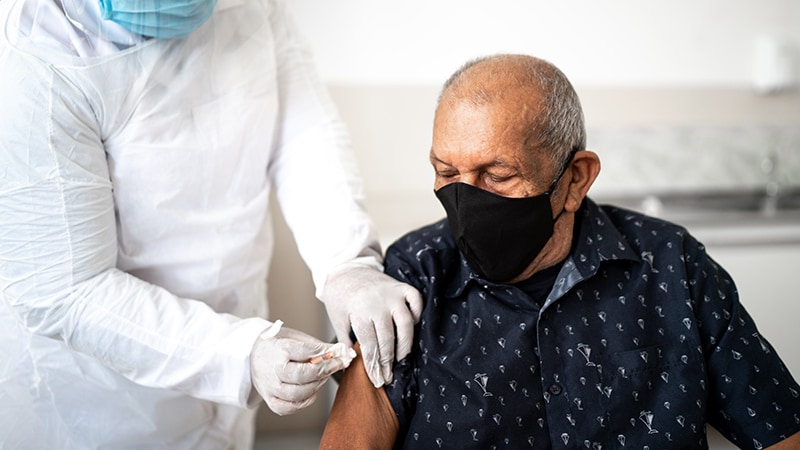Since the B.1.1.529 variant was declared a Variant of Concern and assigned the name Omicron on 26 November 2021, our understanding of this variant has increased considerably, thanks to collaborative global research and the passing of time, allowing us to observe its behaviour and how it affects individuals and communities over a number of weeks.
Unfortunately, as there are knowledge gaps around Omicron, we have seen a great deal of speculation, assumptions and misinformation being communicated about the variant, making it difficult for individuals and authorities to take informed decisions for health protection.
The latest epidemiological data shows that we are now seeing a rapid increase in the rate of infection of COVID-19 in the WHO European Region, largely as a result of the spread of the new Omicron variant. To put this into scale, in September 2021, we were experiencing over 1 million new COVID-19 cases a week, but by the first week of January 2022 this had increased to more than 7 million reported cases in a single week.
Through monitoring the media, social media and common search engine search terms, and working with fact checkers, we are able to address some of the myths surrounding Omicron, and to give more explanation about the actual facts.
Fact: Omicron appears to be less severe than the Delta variant, but it should not be seen as mild.
Myth: Omicron only causes mild disease.
It’s important that we don’t get ahead of ourselves in terms of judging the severity and potential impact of Omicron.
A number of countries have shown that infection-severity from Omicron in their populations has been lower compared to Delta. However, these Omicron impacts have been mostly observed in countries with high vaccination rates in the Region: the comparatively lower rate of hospitalizations and deaths so far is in large part thanks to vaccination, particularly of vulnerable groups. Without the vaccines many more people would likely be in hospital. It is too early to say what impact Omicron will have on the countries with lower vaccination uptake and on the most vulnerable groups.
Fact: Omicron still presents a high risk to our health systems.
Myth: As Omicron is less severe, we will see fewer hospitalizations and our health systems will be able to cope.
The overall risk related to Omicron remains very high for a number of reasons. Current data indicates that Omicron has an even higher growth advantage compared to Delta. Even if an Omicron infection was less severe compared to Delta, the rapid increase in cases will result in an increase in hospitalizations, putting pressures on health care systems for treating patients with both COVID-19 and other types of disease.
Fact: Vaccines offer the best available protection against Omicron.
Myth: Vaccines don’t work against Omicron.
Vaccination is expected to provide important protection against severe disease and death caused by Omicron, as it does with the other variants still in circulation. Up to this point, the comparatively lower rate of hospitalizations and deaths from Omicron is in large part thanks to so many people in our Region already being vaccinated. Vaccination prompts the body’s immune response to the virus, which not only protects us from the variants currently in circulation – including Omicron – but is also likely to give protection from severe disease due to future mutations of COVID-19.
Fact: Unvaccinated people are at most risk from Omicron.
Myth: Unvaccinated people will not become severely ill from Omicron.
It’s really not wise to cross your fingers and hope for the best with Omicron, because the variant will find those people who remain unvaccinated. The sheer volume of new COVID-19 infections is already leading to more hospitalizations in countries where Omicron has become the dominant variant, with most of those who require hospital treatment being unvaccinated people. Where measures to interrupt COVID-19 transmission are absent, the Omicron variant will spread with unprecedented speed, and just like in the Delta wave, the unvaccinated will be hit hardest. Our top recommendation continues to be: Take the vaccination when it’s your turn, including a booster dose if offered.
Fact: Omicron is much more dangerous than a common cold.
Myth: Omicron is just like a common cold.
Omicron is not like a common cold because it is more likely than a cold to land you in hospital. We have seen that people infected with the Omicron variant are being hospitalized and some people have already died as a result of it. It is also expected that people who have been infected from Omicron and recover are also at risk of developing so-called Long COVID conditions.
Fact: Omicron can reinfect people that have previously had COVID-19.
Myth: Previous infection provides immunity from Omicron.
If you have had COVID-19 previously, you should still get vaccinated, as reinfection from Omicron is still possible, with the risk that you could become seriously ill, pass on the virus to others or develop Long COVID. Getting fully vaccinated, whether you have had COVID-19 or not, is the best way to protect yourself and others from severe disease, being hospitalized and potentially dying from the virus.
Fact: Booster jabs are effective at increasing protection against severe disease from Omicron and all other COVID-19 variants.
Myth: Boosters are ineffective against severe disease from Omicron.
The effectiveness of COVID-19 vaccines, as with many other vaccines, such as the one for flu, wanes over time, so if you are offered a booster jab, take it. This will literally boost your protection against severe disease from Omicron and other variants of COVID-19. This advice is especially important for people in at-risk groups, such as those over 60 years of age and people with underlying health conditions, who are at most risk from becoming seriously ill from infection. Health care workers should also get a booster jab due to their high risk of exposure to the virus and the danger of spreading it to the vulnerable people they care for.
Fact: Wearing masks is an effective protective measure to help reduce the infection and spread of Omicron.
Myth: Face masks are useless against Omicron as the gaps in them are larger than the virus.
Based on the evidence that we have so far, all preventive measures that work against the Delta variant continue to be effective against Omicron – and this includes mask wearing. Omicron is moving so quickly that, in addition to vaccination, all other preventive measures – wearing a mask; cleaning hands; physical distancing; avoiding closed, confined or crowded spaces; coughing or sneezing into a bent elbow or tissue; and ensuring good ventilation – are needed to stem the wave of infection and protect health workers and systems.
Fact: The end of the pandemic is not yet in sight.
Myth: With Omicron being less severe, we are nearing the end of the pandemic.
It is important to recognize that we still have some way to go to ending the pandemic. Although we are currently reporting fewer hospitalizations and deaths across the Region as a whole, we are, however, dealing with a huge surge in COVID-19 cases. And even though Omicron is quickly gaining ground in the Region, the majority of current COVID-19 cases is still being caused by the Delta variant, which is known to cause severe disease and death.
In those countries where Omicron is becoming or has become the dominant variant, we are also seeing COVID-19 cases doubling every 1.5 to 3 days – with hospitalizations rapidly rising as a result.
We therefore cannot afford to drop our guard. Regardless of where you live, or your age, you still need to get vaccinated when it’s your turn, with a complete course and booster dose if offered, and continue to take all the other preventive measures, both to protect yourself and others.
Ending the pandemic requires us to get to much higher levels of vaccination in key target groups in the Region and beyond. This is as much about vaccine equity between countries as within countries, and it must include getting all vulnerable individuals and health care workers vaccinated as a priority.
Additionally, misinformation and disinformation fuel mistrust. This puts health and lives at risk; undermines trust in science, institutions and health systems; and hinders the response to the pandemic. Whenever misinformation and disinformation clash with evidence-based science, another person is impeded from making the right decisions to protect their health.
Note: This article have been indexed to our site. We do not claim legitimacy, ownership or copyright of any of the content above. To see the article at original source Click Here













